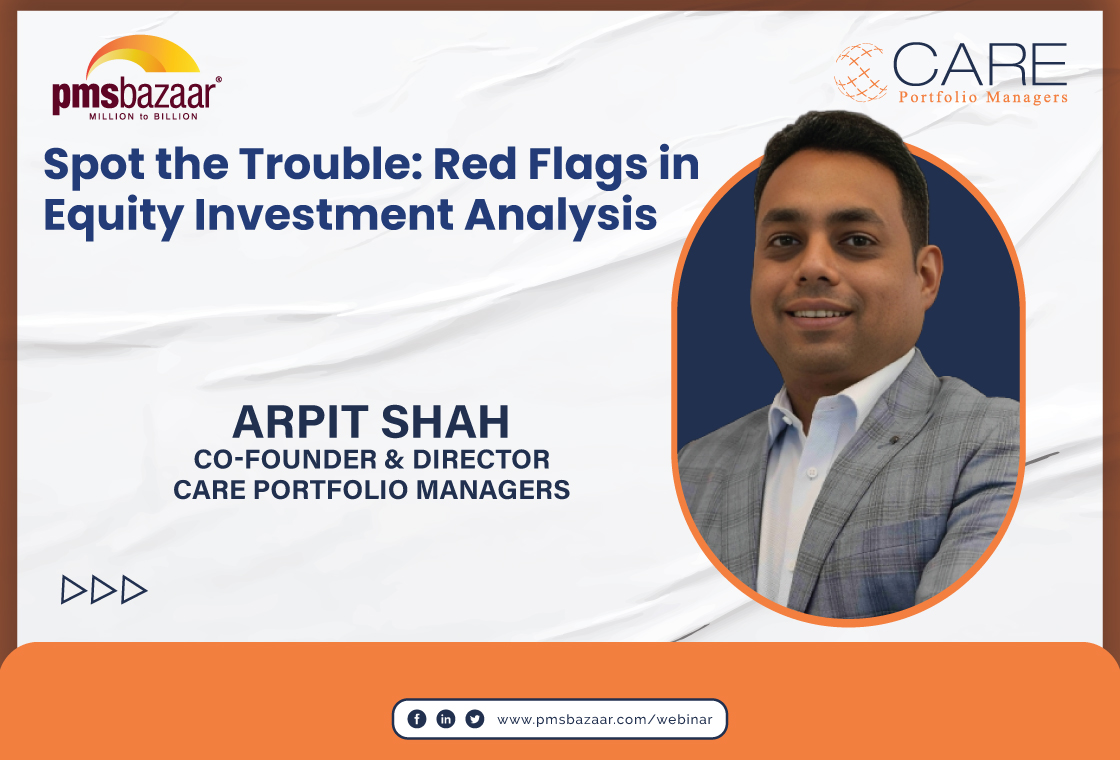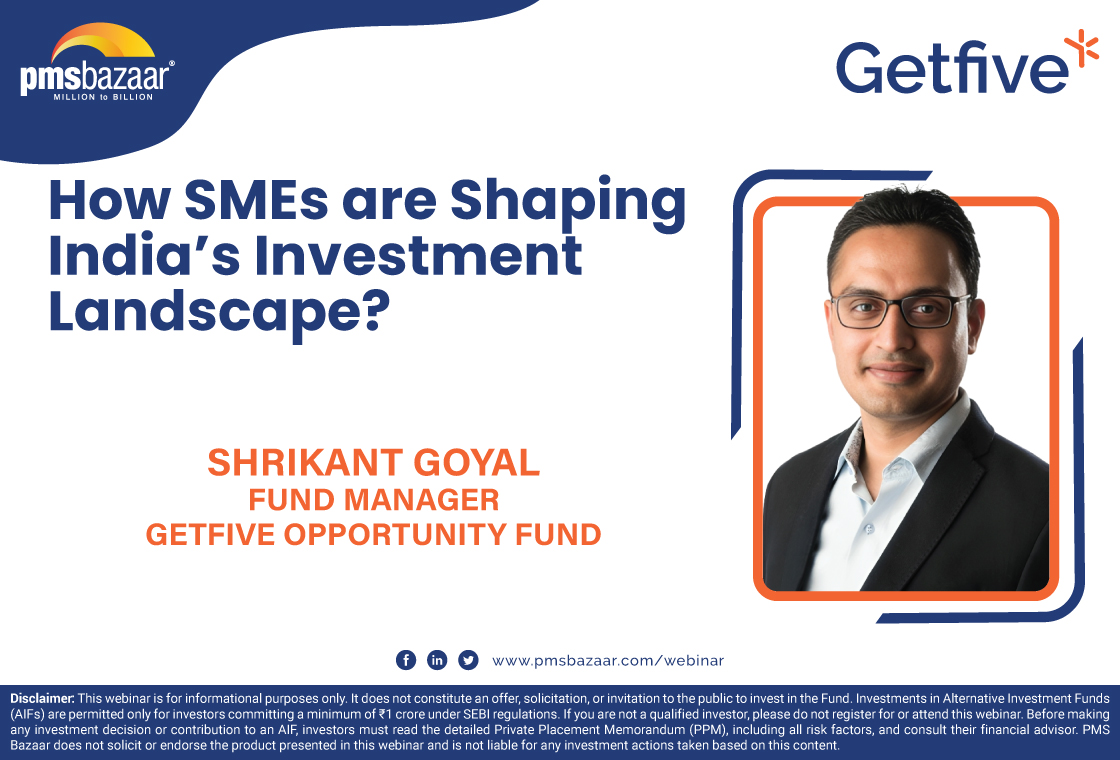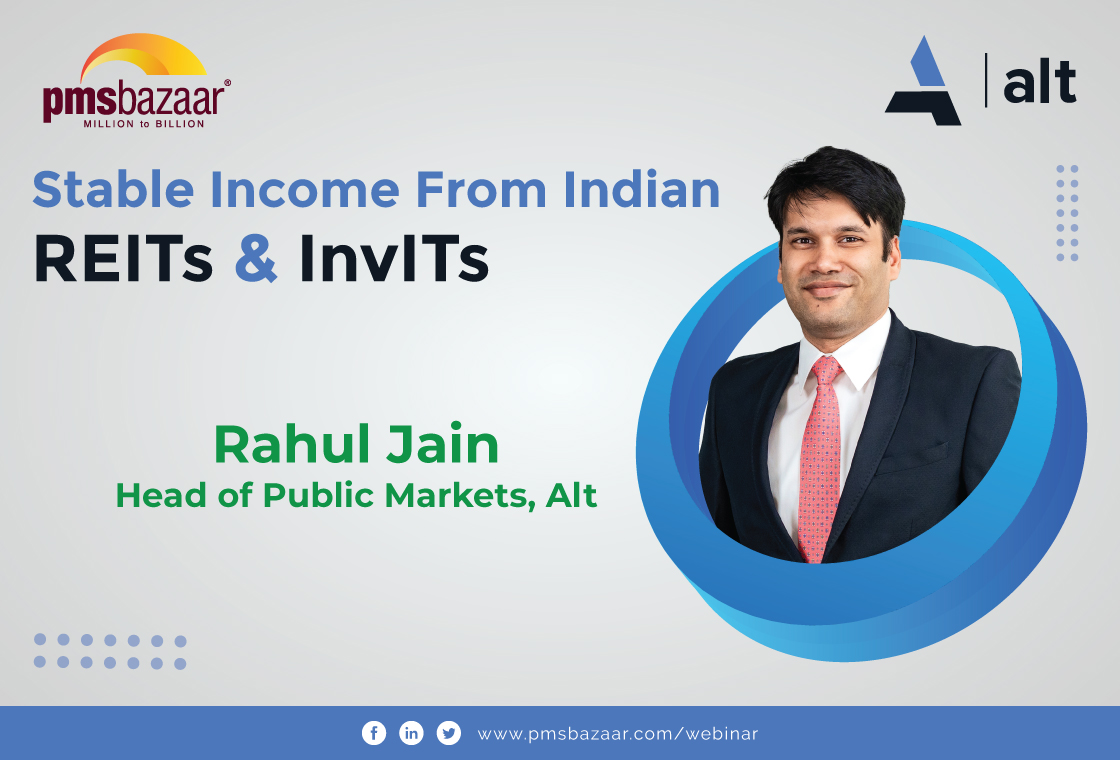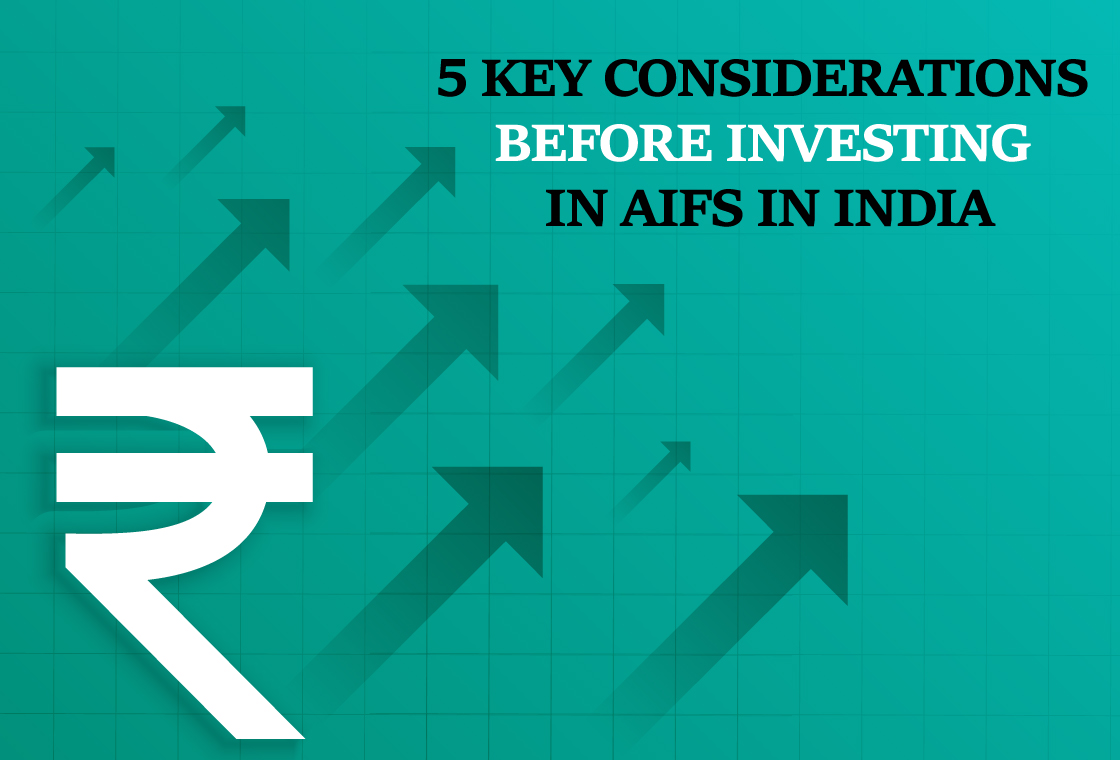In an exclusive webinar with PMSBazaar, Sandeep Daga, Founder, Nine Rivers Capital shares his little-known 'private equity' approach to picking, nurturing and exiting smallcaps that delivered 22.3% CAGR since inception in Dec-2012 compared to mere 4% of Nifty Smallcap 100.

Since asset management boutique firm Nine Rivers Capital runs one of the oldest smallcap focused PMSes in India, investors often ask a fundamental question: "When is a good time to invest in smallcaps?" Nine Rivers Capital Founder Sandeep Daga has a classic answer to that, that begins with an innocuous question. "When was the best time to plant a tree? 20 years ago. When is the next best time to plan a tree? Now," Sandeep quips, breaking into a characteristic boyish smile that is in contrast to his grey-haired demeanour burnished by 26+ years of experience in public / private equity investing and corporate finance.
Serious investors tracking PMSBazaar over the last few months must have noticed how Nine Rivers Capital's Aurum Small Cap Opportunities regularly features in the top monthly performers. In July, it was up 13%. In June, it was up 20.9%. Even in May when markets fell, the strategy out-performed others. The list goes on. And, it is not just a few months where the strategy has shone bright. Over long-term too, the story is similar. Their smallcap PMS, which is built on a 'private equity' approach, has delivered 22.3% CAGR since inception in Dec-2012 compared to mere 4% of the Nifty Smallcap 100. In an exclusive webinar with PMSBazaar on August 14, Sandeep shared his secret sauce to crack open the riches in smallcap investing.
Unique style
The story behind Nine Rivers Capital is special. The company takes inspiration from the nine large rivers that flow through the length and breadth of India breeding civilization and prosperity on their banks for ages. At the heart of Nine Rivers capital is a rich private equity legacy. Sandeep was formerly partner at Frontline Ventures, a growth PE firm focused on mid market investing. This led to investments advised include Astra Microwave, Titagarh Wagons, Shilpa Medicare amongst others.
The PE approach helps, as is evident from the stellar track record of long term alpha generation in Aurum Small Cap Opportunities. "We come from a PE background. The portfolio is built taking 5 years plus investment horizon and we believe in nurturing the portfolio and eventually exiting within this period. We have seen that even the best quality businesses face challenges once the business cycle peaks out and therefore it is necessary to exit " Sandeep says, talking about the exit strategy.
Does this mean there are early exits? "We give 3-5 years. But we have also exited early. When a stock crosses fair value in bull markets, or there is a negative business event or a governance red flag, we will not wait," says Sandeep.
Nine Rivers employs what it calls ‘Price Guardrail Strategy’, which is key to credible risk mitigation. This is essentially a proprietary framework that the firm deploys to assign an ‘entry price guardrail’ and an ‘exit price guardrail’ to each stock that is approved for investment. "We buy a stock as long as it is available within our entry price guardrail and we sell a stock the moment it breaches our exit price guardrail. Our Price guardrail framework has helped us contain excessive volatility and significant drawdown in our portfolio despite the many turbulent events in the market over the last few years," says Sandeep, who led the 11.2x multi-bagger exit in CanFin Homes.
Filtering noise
Smallcaps remain the most enigmatic part of the equity universe . As per AMFI definition, smallcaps form the long tail of the investable stock universe and present over 4,700 options. Usually, this creates a confusion in the minds of the investor. How does one pick promising ones from 4,700 stocks? There are 8 broad points that are common across smallcap multibaggers, says Sandeep. Anyone who follows them diligently can capture huge discovery premium from small caps.
Firstly, the smallcap company must have a solid business franchise – either a leader in its space and/or led by innovation and/or having huge operating leverage. Giving example of a strong business franchise led by innovation, he spoke of Astral Poly "About a decade ago, Astral Poly came out with innovative CPVC Pipes that lasted long and has better properties than the erstwhile cement / GI pipes for same use. Today CPVC pipes are the standard for all kinds of plumbing applications. So here is, a product that isn't even visible once fitted but the company created a strong brand out of it. Another company that Sandeep mentioned was Nilkamal Plastics.
Second point highlighted by Sandeep was the importance of promoters to have a narrow focus on their core business and not getting into unrelated diversification or new businesses. Sandeep quips “If a young single product company suddenly starts calling itself a group and their website starts talking about other unrelated businesses, it’s time to exit’ Further he also stressed on the need for having a strong second line of managers. "Avoid centralized decision making – one man show companies," advises the smallcap expert.
Thirdly, the smallcap company should have a large addressable market – Oligopolies. "Look at Poly Medicure. It operates in a US$ 60 billion+ oligopolistic global market play. Though its global market share is very small, there are only 3-4 players in that area," Sandeep shares his candid thought, adding that the names he is mentioning should be read with a disclaimer that these are not stock calls. "We have made a lot of mistakes too, and we learn from them. Overall, we made more correct calls than wrong ones," he adds, the honesty in his appeal not missing.
The fourth important point he made is that he looks for growth with profitability and avoids mindless chasing of growth. Some entrepreneurs can lose sight of profits in their pursuit of growth and end up taking risk calls that they usually regret later.
No debt, yes to income tax
The fifth point that forms a bulwark of successful smallcap investing is avoiding companies with debt. "Have debt aversion – debt is a bad word! Our portfolio companies have zero or marginal debt, with ample liquidity. In fact, 9 out of 15 have negative Net Debt. The most leveraged company has a very conservative 0.4 : 1 Net-Debt : Equity ratio. We think less debt gives a smallcap company the ability to comfortably survive an extended macro-downturn – a major competitive advantage," says Sandeep.
The sixth point to be noted is that the smallcap business must generate free cash - that can be reinvested in business growth. This is connected to the debt parameter, because when a business generates cash it can use it to fund expansion, thus side-stepping the need to take external financing.
The seventh parameter in successful smallcap investing is whether the company pays Income Tax. "Yes, as quirky as it may sound, this is something we look at. There are valid reasons why we do that. We strongly believe that the real measure of profit is taxes. On paper, there may be huge profits. But if the company doesn't pay income tax, something doesn’t add up. There could be big receivables, write offs that may be eating into the profits," Sandeep says.
The 8th and last point is the smallcap business should be high on the “ESG” quotient. This means it has to respect the environment, people and corporate governance.
Investing is no zero-error profession. But, most professional fund managers are not that forthcoming when it comes to discussing their mistakes. Sandeep is an exception to this rule.
Sometimes companies bite more they can chew.
"We have made many mistakes. I could go on and on about them. Take for example, one company we invested that makes sensors and other control systems for vehicles. We understood the Indian part of the business very well. But for the overseas businesses, we went with the management representation, we believed what they said. We later realized that managing a large overseas operation for this smallcap company proved to be extremely challenging leading to massive losses" he shares.
Sometimes companies reliance on one sales channel backfires.
Videocon used to be the largest mass-market brand in India. When it went down, there was an opportunity for newer players to go and capture that market share. We invested in a company that was reviving an age old television brand and interestingly, rather than going the traditional inventory led distribution strategy, they tied up with one of the online biggies for selling their televisions. All went well with sales showing strong growth and brand becoming eminently visible. Alas! A policy change came in and marketplaces were subject to caps on inventory holding. With no alternate distribution channel in place, the company suffered big time. We learned a valuable lesson learned on the impact of policy changes for companies that have complete dependence on one channel," Sandeep says.
Patience pays
One of the common things said about smallcap investing is high risk. Yes, there is high risk whenever there are potential high returns. But, investors fail to appreciate the power of patience.
High Volatility, Low Liquidity and Susceptibility to sharp and significant corrections (drawdowns) in market downturns often scares investors. "Look at Hero Motocorp over the last 20 years. You can see how its stock had 5 major drawdowns of over 20% each. But, if you remain anchored to such a business, the returns are handsome. Hero MotoCorp delivered a 19x value growth despite multiple double-digit falls. This is what long-term investing does. Every draw-down in Hero was in fact an opportunity to add and turbo-charge returns," Sandeep remarks.
He went on to explain how many small caps of yesteryears are mid/large caps now! Just to name a few - Astral Poly, Bajaj Finance, Hawkins, Shree Cement, Honeywell Automation, Titan and Eicher Motors.
But, this does not mean one should ignore red-flags.
The first red-flag is something touched upon earlier - Centralized Decision Making – One Man Show.
The second one is Midas touch / rockstar managements who promise the moon. "They will come and paint these too good to be true stories. Avoid them because they will be disconnected from reality, they will underplay risks and challenges and more so they will be closed to questioning," is Sandeep's honest advice
The third important red-flag to watch out for is a smallcap business with no focus – chasing too many opportunities too early; ever changing priorities.
Another red-flag is accounting inconsistencies, frequent surprises. "If the numbers don’t tie up with the story, avoid” Sandeep quips.
Lastly, too many related party transactions are always a red flag, especially in a smallcap
When everything is put together, the Indian listed universe of 5000+ stocks narrows to a core hunting ground of just 250-300 companies. "We believe that generating superior risk adjusted long term returns from small/mid cap companies require application of the same rigor and discipline as in private equity investing, something that is amply demonstrated in our exemplary track record," Sandeep signs off.
Those who missed the opportunity to hear from the Experts directly can listen to the entire session through the appended link:
For more information, please contact info@pmsbazaar.com
Recent Blogs
.jpg)
Passively Active Investing — A Modern Investor’s Lens on ETF-Based PMS
PMS Bazaar recently organized a webinar titled “Passively Active Investing — A Modern Investor’s Lens on ETF-Based PMS,” which featured Mr. Karan Bhatia, Co-Founder and Co-Fund Manager , Pricebridge Honeycomb ETF PMs. This blog covers the important points shared in this insightful webinar.

Spot the Trouble: Red Flags in Equity Investment Analysis
PMS Bazaar recently organized a webinar titled “Spot the Trouble: Red Flags in Equity Investment Analysis,” which featured Mr. Arpit Shah, Co-Founder & Director, Care Portfolio Managers. This blog covers the important points shared in this insightful webinar.

Long-Only AIFs Rebound Sharply in October; Long-Short Strategies Lag Despite Lower Volatility
106 long-only AIFs averaged 3.68% vs 32 long-short AIFs at 2.7%; only 24–31% of funds beat key indices

Markets log strongest monthly gains in 7 months; PMS performance turns near-uniform in October
Nifty 50 TRI gained 4.62%, BSE 500 TRI rose 4.27%; 415 of 427 equity PMSes ended positive

How SMEs are Shaping India’s Investment Landscape?
PMS Bazaar recently organized a webinar titled “How SMEs are Shaping India’s Investment Landscape?” which featured Mr. Shrikant Goyal, Fund Manager, GetFive Opportunity Fund.

Stable Income from Indian REITs and InvITs
PMS Bazaar recently organized a webinar titled “Stable Income from Indian REITs and InvITs,” which featured Mr. Rahul Jain, Head of Public Markets, Alt.

5 Key Considerations Before Investing in AIFs in India
Alternative Investment Funds (AIFs) have emerged as a compelling option for sophisticated investors seeking diversification and potentially superior returns. But venturing into AIFs requires a clear understanding of their unique characteristics that go beyond simply knowing what they are and their categories.

How AIF can help in diversification?
Traditionally, Indian investors have relied on a mix of stocks and bonds to build their wealth. While this approach offers diversification, it can still leave your portfolio vulnerable to market fluctuations. Enter Alternative Investment Funds (AIFs), a dynamic asset class gaining traction for its ability to unlock diversification beyond the realm of conventional options.

